Last updated on December 2nd, 2011
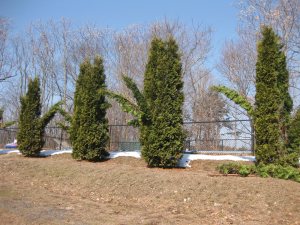
MEA CULPA. Prior to this morning’s repair work, my arborvitaes (above), which form a row before the fenced-in swimming pool, looked like they had sprouted wings. Who can blame them? Perhaps they wished to fly away from the gardener who, ignoring his own advice, neglected to shake February’s heavy, wet snow from their evergreen branches. That frosty white burden caused stems to bend, and at least one branch to break. If your multi-leader shrubs are winter-battered too, don’t despair…repair! A pruning-saw and a spool of twine are all you need to set matters upright again:
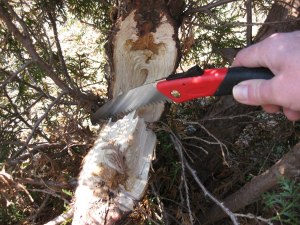 Split or Broken Limbs
Split or Broken Limbs
A pruning saw is the only cure for a severed limb. Once cut, do not apply a wound-dressing of any kind, for it will invite moisture and decay. Let the shrub produce its own, natural seal.
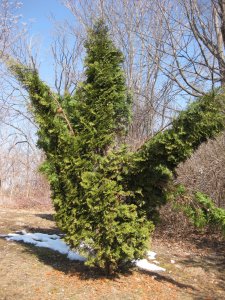 Bent Branches
Bent Branches
To encourage bent or drooping branches to grow upright again, loosely tie them with twine to the sturdy, central leader. I used green, 3-ply “jute” twine to repair all of my arborvitaes, including the horribly damaged one above. Jute twine is a soft, pliable, and biodegradable material that doesn’t harm stems.
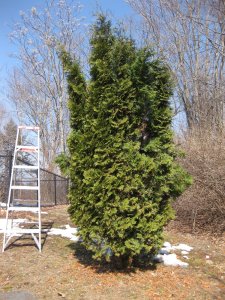 The same shrub, after tying (click to enlarge). The green twine is completely inconspicuous.
The same shrub, after tying (click to enlarge). The green twine is completely inconspicuous.
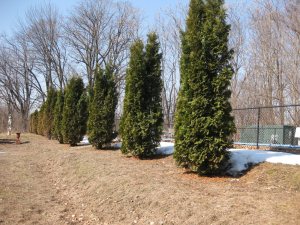 Leashed into position, arborvitaes soon give up their aviary dreams and resume an attractive, upright habit. And incidentally, future snow-damage can be avoided entirely. An acquaintance in Minnesota told me that gardeners there routinely truss — from bottom to top — their arborvitaes in November. This certainly sounds like a good plan. But what a job when you have dozens of shrubs to truss, and nary a helper in sight!
Leashed into position, arborvitaes soon give up their aviary dreams and resume an attractive, upright habit. And incidentally, future snow-damage can be avoided entirely. An acquaintance in Minnesota told me that gardeners there routinely truss — from bottom to top — their arborvitaes in November. This certainly sounds like a good plan. But what a job when you have dozens of shrubs to truss, and nary a helper in sight!
For more gardening tips and hints, sign up for Kevin’s weekly newsletter.
Related Posts:
Evergreens for Privacy Screens
Boxwood Beauty the Easy Way
Pachysandra: Exploding the “Shade-Only” Myth

Eric says
That snowstorm did a real number on my arbs, too. Glad we have nice weather to get repair work done!
Janis in Chicago says
Heavy, wet snow is a problem here too with multi-leader shrubs. Trussing in the fall is a good idea.
Your arbs look really healthy, though. I suspect they'll recover nicely.
Sally says
Is jute twine a common hardware item? Or can you only buy it at garden centers? I have a lot of damage in my yard…broken branches, bowed stems, a smashed forsythia…yikes!
Kevin Lee Jacobs says
Sally – I think jute twine — including the kind that's dyed green — can be easily found at any hardware store.
Don't worry about your forsythia. Such a hardy shrub. It will return to its fountainous form once the snow melts.
Justin says
Kevin, the before and after pictures are amazing. Good work!
Andrew says
Interesting that you are against the use of sealant. I thought cuts on trees and shrubs had to be coated, in order to heal.
Kevin Lee Jacobs says
Andrew – according to authorities much higher than me, sealants do not prevent rot or decay on wounded wood. They do, in fact, inhibit a tree or shrub's ability to form a callus over a wound. Also, some sealants eventually crack, thus exposing a wound to pathogens.
And that's why I'm opposed to wound-dressings!